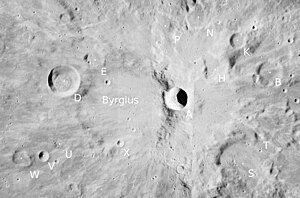Byrgius (crater)
Appearance
 Lunar Orbiter 4 image of Byrgius, with Byrgius A at right, and Byrgius D in upper left | |
| Coordinates | 24°42′S 65°18′W / 24.7°S 65.3°W |
|---|---|
| Diameter | 87 km |
| Depth | 4.6 km |
| Colongitude | 65° at sunrise |
| Eponym | Joost Bürgi |

Byrgius is a lunar impact crater located in the western part of the Moon, near the limb. As a result, Byrgius appears strongly oval in shape due to foreshortening. To the northwest is the nearly ruined crater Lamarck. The rim of Byrgius is worn and eroded, with Byrgius A overlying the eastern rim and Byrgius D lying across the northwest. The floor is relatively flat and undistinguished by significant craterlets. Byrgius A possesses its own ray system that extends for over 400 kilometres.
Satellite craters
By convention these features are identified on lunar maps by placing the letter on the side of the crater midpoint that is closest to Byrgius.
| Byrgius | Latitude | Longitude | Diameter |
|---|---|---|---|
| A | 24.5° S | 63.7° W | 19 km |
| B | 23.9° S | 60.8° W | 23 km |
| D | 24.1° S | 67.1° W | 27 km |
| E | 23.5° S | 66.2° W | 18 km |
| H | 23.7° S | 62.4° W | 27 km |
| K | 23.0° S | 61.8° W | 14 km |
| N | 22.3° S | 63.1° W | 20 km |
| P | 22.6° S | 64.1° W | 19 km |
| R | 26.5° S | 60.7° W | 7 km |
| S | 26.2° S | 61.4° W | 43 km |
| T | 25.1° S | 61.5° W | 5 km |
| U | 25.8° S | 67.2° W | 13 km |
| V | 26.0° S | 67.8° W | 9 km |
| W | 26.1° S | 68.5° W | 14 km |
| X | 25.7° S | 65.4° W | 6 km |

References
- Andersson, L. E.; Whitaker, E. A. (1982). NASA Catalogue of Lunar Nomenclature. NASA RP-1097.
{{cite book}}: Invalid|ref=harv(help) - Blue, Jennifer (July 25, 2007). "Gazetteer of Planetary Nomenclature". USGS. Retrieved 2007-08-05.
{{cite web}}: Invalid|ref=harv(help) - Bussey, B.; Spudis, P. (2004). The Clementine Atlas of the Moon. New York: Cambridge University Press. ISBN 978-0-521-81528-4.
{{cite book}}: Invalid|ref=harv(help) - Cocks, Elijah E.; Cocks, Josiah C. (1995). Who's Who on the Moon: A Biographical Dictionary of Lunar Nomenclature. Tudor Publishers. ISBN 978-0-936389-27-1.
{{cite book}}: Invalid|ref=harv(help) - McDowell, Jonathan (July 15, 2007). "Lunar Nomenclature". Jonathan's Space Report. Retrieved 2007-10-24.
{{cite web}}: Invalid|ref=harv(help) - Menzel, D. H.; Minnaert, M.; Levin, B.; Dollfus, A.; Bell, B. (1971). "Report on Lunar Nomenclature by the Working Group of Commission 17 of the IAU". Space Science Reviews. 12 (2): 136–186. Bibcode:1971SSRv...12..136M. doi:10.1007/BF00171763.
- Moore, Patrick (2001). On the Moon. Sterling Publishing Co. ISBN 978-0-304-35469-6.
{{cite book}}: Invalid|ref=harv(help) - Price, Fred W. (1988). The Moon Observer's Handbook. Cambridge University Press. ISBN 978-0-521-33500-3.
{{cite book}}: Invalid|ref=harv(help) - Rükl, Antonín (1990). Atlas of the Moon. Kalmbach Books. ISBN 978-0-913135-17-4.
{{cite book}}: Invalid|ref=harv(help) - Webb, Rev. T. W. (1962). Celestial Objects for Common Telescopes (6th revised ed.). Dover. ISBN 978-0-486-20917-3.
{{cite book}}: Invalid|ref=harv(help) - Whitaker, Ewen A. (1999). Mapping and Naming the Moon. Cambridge University Press. ISBN 978-0-521-62248-6.
{{cite book}}: Invalid|ref=harv(help) - Wlasuk, Peter T. (2000). Observing the Moon. Springer. ISBN 978-1-85233-193-1.
{{cite book}}: Invalid|ref=harv(help)

